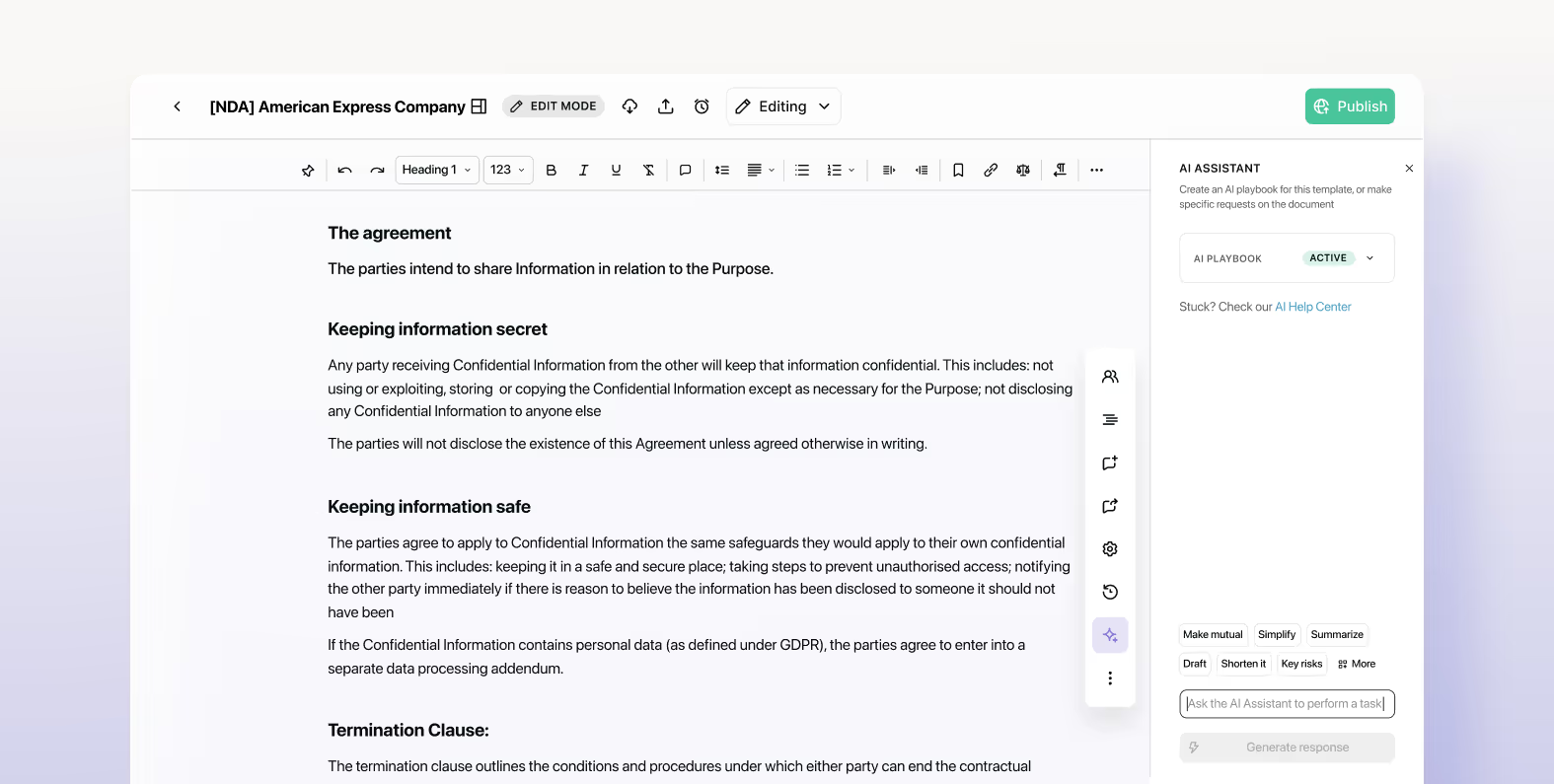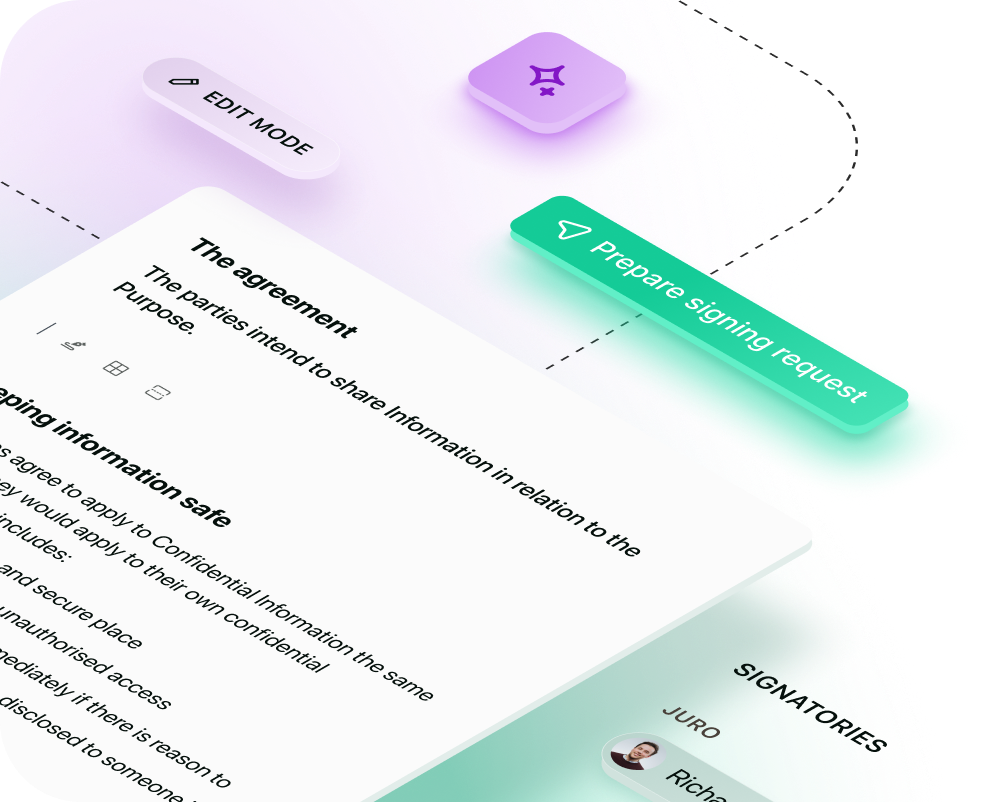Solutions
Customer Support
Resources
Use this customizable loan modification agreement template to update the terms of an existing lending agreement and keep parties on the same page.




A loan modification agreement is a critical tool for businesses to restructure existing loan terms and conditions, providing relief and ensuring continued repayment.
This comprehensive guide will explain everything you need to know about loan modification agreements – from their purpose and management to the challenges they present – and how Juro can streamline the process.
A loan modification agreement is a document that alters the terms of an existing loan agreement. This can include changes to the loan amount, interest rate, repayment terms or other key terms.
It is typically used when the borrower is unable to meet the original terms of the loan but still wishes to avoid default. This is common in the following situations:
Loan modifications can be mutually beneficial for both lenders and borrowers, providing a way to adjust the agreement to reflect the borrower's current financial situation.
The primary purpose of a loan modification agreement is to provide financial relief to the borrower while ensuring the lender recovers their loan amount. Here are some key purposes:
Lenders – the financial institutions or private lenders who hold the original loan agreement – are responsible for approving and managing loan modifications. Borrowers – the businesses or individuals seeking to alter the terms of their loan – must negotiate with the lender and comply with the modified terms.
Legal teams may be involved to ensure the modification complies with all applicable laws and regulations. And financial advisors can help borrowers understand the implications of the modification and assist in negotiations with the lender.

Loan modification agreements are used in various scenarios to provide tailored solutions that help borrowers maintain their financial stability and avoid default. Below are some common use cases and examples.
A borrower is struggling to keep up with high-interest payments due to a recent financial setback, such as job loss or medical emergency.
Example: John, who recently lost his job, negotiates with his lender to reduce the interest rate on his mortgage from 6% to 4%. This lowers his monthly payment, making it more manageable while he seeks new employment.
A borrower needs more time to repay their loan due to unexpected financial difficulties or a prolonged decrease in income.
Example: Sarah, a small business owner affected by a downturn in sales, extends her 15-year mortgage to a 30-year term. This reduces her monthly payments, allowing her to focus on stabilizing her business.
A borrower faces temporary financial hardship and needs short-term relief from making full loan payments.
Example: Mark, who is recovering from a serious illness, negotiates a forbearance agreement with his lender. For six months, he only pays interest on the loan, deferring the principal payments until he is back on his feet.
A borrower owes more on their mortgage than the current value of the property (underwater mortgage) and is at risk of default.
Example: Emily’s home value has decreased significantly due to a market crash. Her lender agrees to reduce the principal balance from $300,000 to $250,000, aligning the loan with the current market value and preventing foreclosure.
A borrower wants to avoid the uncertainty of fluctuating interest rates, especially if rates are expected to rise.
Example: Tom has an adjustable-rate mortgage (ARM) with rates set to increase. To gain stability, he converts to a fixed-rate mortgage with a stable interest rate, ensuring predictable payments for the remaining loan term.
A borrower anticipates future income recovery but needs immediate relief from high monthly payments.
Example: Jane, a seasonal worker, negotiates a temporary payment reduction for the off-season months when her income is lower. The lender agrees to reduced payments for six months, with the understanding that the difference will be added to future payments.
A borrower wants to simplify their financial obligations by consolidating multiple debts into a single loan with better terms.
Example: Mike consolidates his high-interest credit card debts into his mortgage by refinancing. This results in a lower overall interest rate and a single, more manageable monthly payment.
A borrower with a weak credit profile seeks to improve loan terms by adding a co-borrower with a stronger credit history.
Example: Lisa, who has a low credit score, adds her sister as a co-borrower. With her sister’s strong credit profile, they secure a lower interest rate and more favourable loan terms.

A comprehensive loan modification agreement template should include the following elements:
Identification of parties. Names and addresses of the lender and borrower.
Original loan details. Reference to the original loan agreement, including the date and loan amount.
Modification terms. Detailed description of the changes being made to the loan terms, such as interest rate, repayment schedule, and loan amount.
Representations and warranties. Statements from both parties affirming their authority to enter into the agreement and that the modification will not violate any other agreements.
Conditions precedent. Requirements that must be met before the modification becomes effective, such as payment of fees or submission of documents.
Confidentiality. Provisions to protect the confidentiality of the terms and any shared information.
Governing law. The legal jurisdiction that will govern the agreement.
Signatures. Signatures of authorised representatives from both parties.
Managing loan modification templates manually involves a series of detailed steps to ensure each agreement is tailored to individual borrower needs while also maintaining legal and regulatory compliance. Here's how the manual process typically works:
1. Template creation
2. Storage and access
3. Customization for each borrower
4. Review and finalization

Managing loan modification agreement templates can present several challenges:
Automating loan modification agreements can significantly enhance efficiency, reduce errors, and improve the borrower experience. Juro’s AI-native contract management platform offers several features that can help businesses streamline this process:
Automated drafting. Use Juro’s AI-powered tools to create standardized loan modification agreement templates. These templates can be pre-approved by legal teams and stored within Juro’s centralized repository.
Dynamic fields within templates can be automatically populated with borrower-specific information, reducing manual input and errors.
Secure repository. Store all templates and completed agreements in Juro’s secure, cloud-based repository, making sure that authorized personnel can access them easily when they need to.
Version control. Juro’s version control features enables you to track changes, maintain document integrity and ensure that all team members are working with the most current version of each template.
Data integration. Integrate Juro with your existing CRM or loan management system to automatically pull borrower information and populate the relevant fields in the loan modification agreement.
Conditional logic. Use conditional logic in templates to include or exclude specific clauses based on the borrower’s unique circumstances, ensuring each agreement is tailored appropriately without having to make manual adjustments.

Internal review. Streamline internal reviews with Juro’s collaborative workflow features, allowing multiple team members to review, comment on and approve agreements in real-time within the platform.
Borrower interaction. Send agreements to borrowers for review and signature directly through Juro, enabling them to provide feedback or eSign the document without leaving the platform.
Native eSignatures. Juro’s native electronic signature functionality allows you to execute agreements quickly and securely, eliminating the need for physical document handling and reducing turnaround times.
Automated reminders. Set up automated reminders and notifications to ensure timely reviews, approvals, and signatures from all parties involved.
.avif)
Automated storage. Once signed, agreements are automatically stored in Juro’s centralized contract database, where they can be easily retrieved and referenced.
Analytics and reporting. Leverage Juro’s analytics and reporting tools to gain insights into contract performance, identify bottlenecks and optimize the loan modification process.
Juro's AI-native contract automation platform empowers all teams to create, agree, execute and manage contracts up to 10x faster than traditional tools. To find out more, hit the button below to book your personalized demo.
Juro is the #1-rated contract platform globally for speed of implementation.


Juro embeds contracting in the tools business teams use every day, so they can agree and manage contracts end-to-end - while legal stays in control.
Book your demo